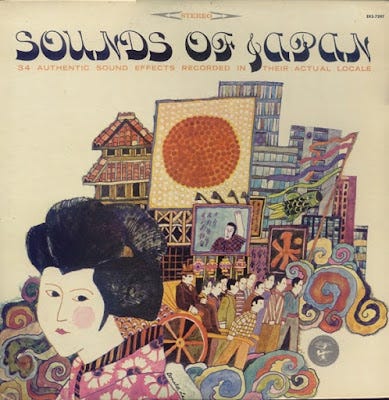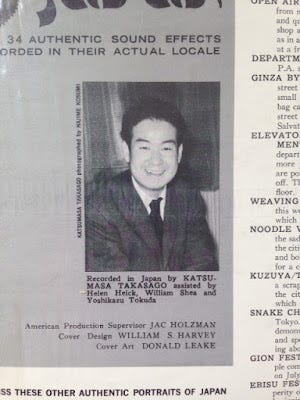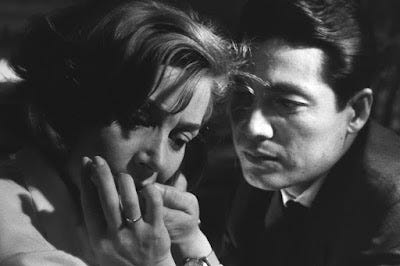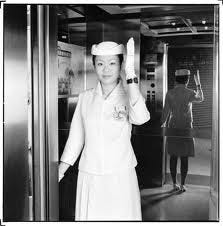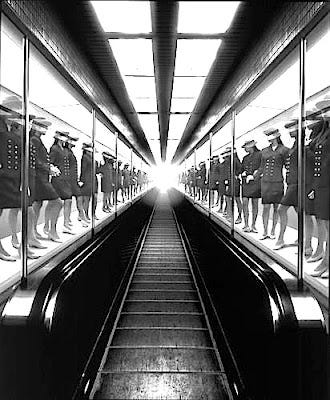For the past 25 years, I have been going to Japan every year. Usually, I spend up to a month to two months at a time in Tokyo. The funny thing is I have no visual memory of that country. What I do remember are the sounds of Japan. Primarily because I own "Sounds of Japan." It is 34 authentic sound effects recorded in their actual locale. The album was put together by Katsumasa Takasago, who I know very little about.
The beauty of such recordings is that one doesn't have to leave home to appreciate another country's culture. In 1965, I didn't think that many American tourists went to Japan, yet here we have everyday sounds of a city that looks back to its past but is also very much part of the present life. 1965 can be 1975 as well as 2022. I try to imagine what it must be like to listen to this album in 1965. You never were in Japan, yet, you're thrown into a soundtrack to a movie that you imagine you have seen but never actually saw.
I think of Alain Resnais' film "Hiroshima mon amour," starring Emmanuelle Riva and the Japanese actor Eiji Okada. Marguerite Duras wrote the film script. It deals with memory, but as the powers of recall, it is always one's point-of-view, and therefore there is no truth. So when a tourist approaches a 'foreign' country or city, it is from the point of view of the visitor, who may or may know anything about the culture, but has at least heard of it.
Listening to this album on a Sunday morning is like traveling through a Japanese city with your eyes closed. One can quickly feel or taste the country just by listening to the album. The Snake Charmer in Asakusa on this album is more likely dead, but his son has taken over his spot in that beautiful part of Tokyo. The snake charmer demonstrates the lovemaking of snakes, which greatly amuse the children that walk by him. There is something sinister about such a profession, especially when late daylight turns into evening. In the darkness, there is another world. Asakusa is the old downtown of Tokyo, and there is quite a difference between day and night. All of Tokyo's changes of identity - it is not that dissimilar to Bruce Wayne when he puts the bat mask on. Another personality takes over the city as soon as the neon lighting is turned on.
"Last Year at Marienbad" can quickly turn into "Last Year at Tokyo." I want to wander through the streets of the Ginza to locate the lost love I had there. Once I find her, will she remember me? Perhaps not. The faint texture of being forgotten, left, or abandoned is part of the Japanese feeling. When I go by a bar and hear the hostess sing float beyond the entrance door, I think of her. It is never a city of now but a city of memories. This album represents memories. Even when the record came out in 1965, it was already a memory.
"Elevator girls at Takashimaya Department Store" would announce each floor in a high-pitched accent with an ultra-feminine voice. Promoting the goods on each floor, one is, in a sense getting a floor show at a supper club, but alas, it is in an elevator. The perfect choreographed gestures of using their white-gloved hands to express what is on each floor and announce the upcoming floor number. One is not encouraged to talk to them. It would be like talking to an actor on stage while performing.
It's odd for me to sit here this Sunday morning in Silver Lake and listen to this album. Whenever I leave Japan, I feel great sadness. I have almost a fear that I won't stay alive till the next visit. I never wanted to think that this would be my last visit to Tokyo. "Sounds of Japan" is my safety net. As long as I have this album, Japan will never leave me. It is extraordinary to listen to this album. Even though it was recorded in 1965 in various parts of Tokyo and Kyoto, I still feel that it could have been recorded today. Nothing has changed. Yet everything has changed—the story of my life.



